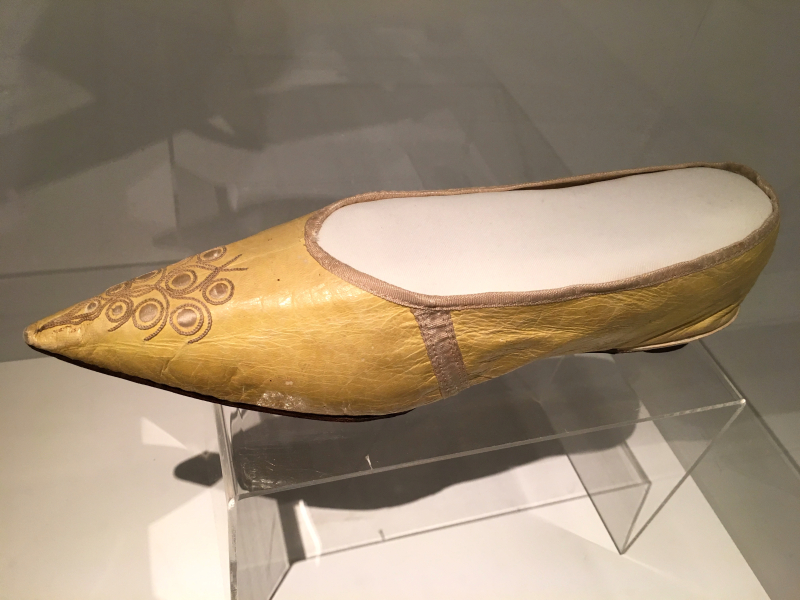The Empire Era Silhouette
Our recent exhibition Majesty & Mystery: Saving a Napoléonic Court Gown introduced visitors to the magnificent royal court of Napoléon Bonaparte and Empress Joséphine. The gold and silver splendor seen in the court ensemble on display (currently the focus of our Operation 1804 fundraising campaign) was a marked contrast to the evening dress also shown in the gallery; this fine white muslin creation perfectly illustrated the shift towards simplicity in early 1800s fashion.
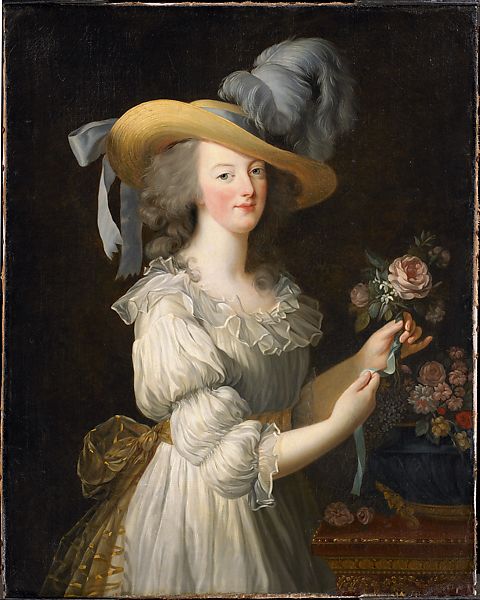
"Marie Antoinette in a Chemise Dress," 1783 Élisabeth Louise Vigée Le Brun (French, 1755 - 1842) Courtesy of The Metropolitan Museum of Art
Even before the Revolution, French fashion was gradually embracing more streamlined silhouettes and humble fabrics. Élisabeth Louise Vigée Le Brun’s 1783 portrait of Marie Antoinette captured the monarch wearing her infamous ‘chemise à la reine,’ a layered white muslin frock that represented the queen’s love of the countryside and her idealized view of peasant life. Though the painting subsequently caused a public outcry because the queen’s attire so resembled an undergarment, members of high society eagerly adopted the gown’s looser style and lightweight fabric. Post-Revolution, this simplified silhouette morphed once again as society looked to the Democratic ideals of ancient Greece and Rome, resulting in fashions that emulated marble statues and Ionic columns. White, semi-sheer, form-fitting gowns with high waistlines directly under the bust were now worn over pale slips, echoing the casually draped garments of ancient civilizations.
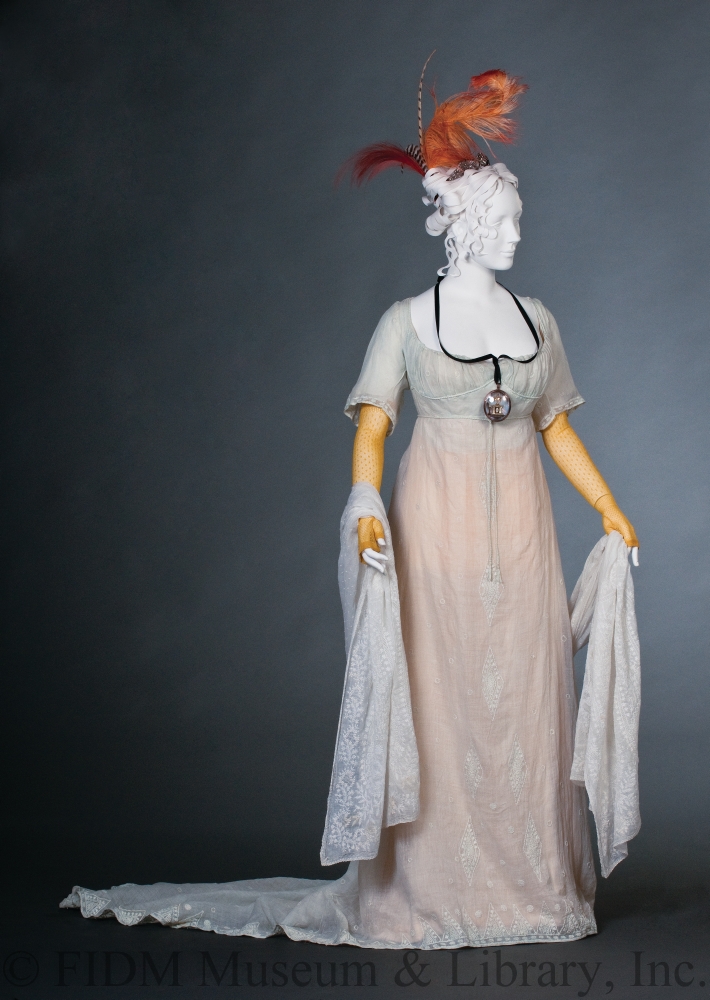 Muslin evening dress, c. 1803 FIDM Museum Purchase 2009.5.6
Muslin evening dress, c. 1803 FIDM Museum Purchase 2009.5.6
These stark dresses became the perfect canvases to show-off accessories such as fine cashmere paisley shawls, unique headwear, and of course, eye-catching shoes. The slender cut of skirts ensured that shoes would certainly be visible, thus emphasizing the need for brightly colored and beautifully trimmed footwear.
 Kid leather shoes, c. 1800 FIDM Museum Purchase 2017.5.123AB
Kid leather shoes, c. 1800 FIDM Museum Purchase 2017.5.123AB
From the 1790s to the 1830s, women’s shoes underwent a drastic transition from ornately buckled Louis-heeled pumps to lightweight flat slippers. The 1805 pair featured in our Majesty & Mystery exhibition represent a midway point of that transition: the Louis heel has drastically lowered into an Italian heel, a shortened style that extends further under the arch of the shoe. The toes are quite pointed, another indicator of this transitional period, with a long vamp (the area between the opening of the shoe and the tip of the toe) and rounded thoatline. This pair is made of kid leather - a popular material for shoes at the beginning of the 19th century - in a cheerful lemon yellow, one of many bright colors used for shoes that would peek out from underneath a slim skirt. Decorative white embroidery and ribbon trim add a final touch of visual interest.
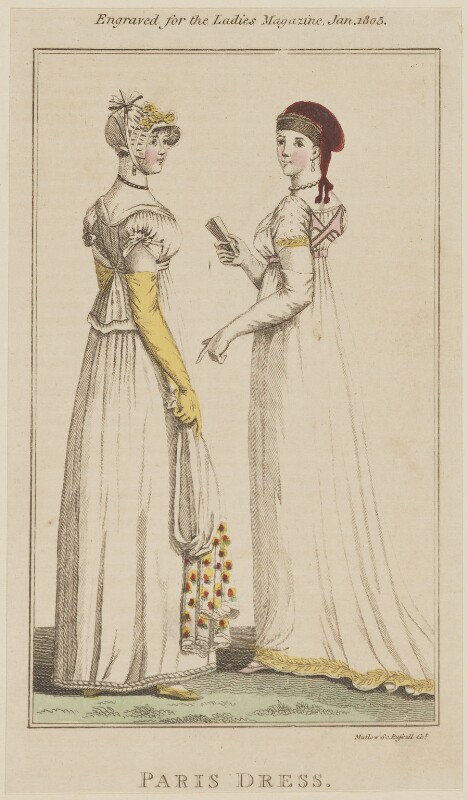
'Paris Dress', January 1805, The Lady's Magazine Courtesy of The National Portrait Gallery.
At the dawn of the new century, wealthy women received up-to-date fashion information from periodicals such as Journal des dames et des modes; despite the political upheaval, France remained the arbiter of taste. The French love of antiquity spread throughout European society as fashion journals proclaimed, “Coloured robes are now entirely laid aside, on the public walks white only is to be seen; no gaudy colour now offends the eye, the utmost neatness and simplicity prevail.” The fashion plates that graced the pages of these magazines illustrated how accessories brought the white gowns to life with pops of color. The above 1805 fashion plate from England's The Lady’s Magazine shows the latest “Paris Dress;” note the coordinating yellow slippers, gloves, and even the flowers adorning the bonnet...one can imagine the Museum’s shoes fitting right in with this stylish vignette!
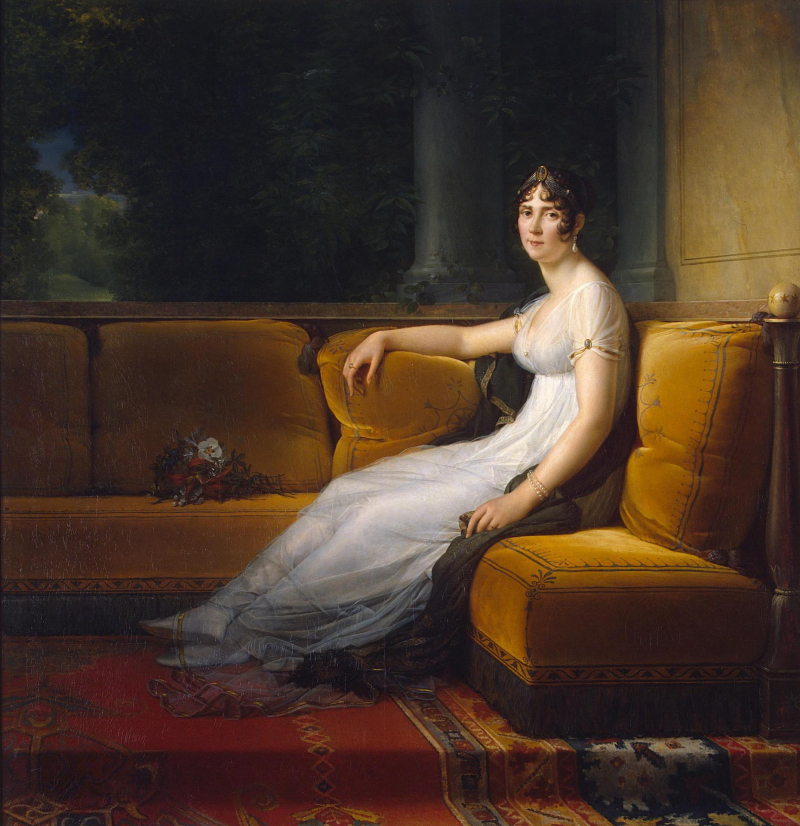 "Portrait of Josephine, the Wife of Napoleon" 1801 François Gérard (French, 1770 - 1837) Courtesy of the State Hermitage Museum
"Portrait of Josephine, the Wife of Napoleon" 1801 François Gérard (French, 1770 - 1837) Courtesy of the State Hermitage Museum
Though exceedingly more embellished than most gowns, the 1804 ensemble in Majesty & Mystery follows the contemporary silhouette of a low neckline, high waistline, and slim skirt - quite a departure from the extensive panniers seen in the 18th century. When she was not dressed for court, Empress Joséphine wore the diaphanous gowns so loved by her peers (albeit in the finest silk gauze with gold ribbon trim). Apparently the empress particularly enjoyed amassing accessories; it is said that she purchased custom slippers and bottines to match every ensemble in her wardrobe each season. You can help us get one step closer to acquiring the exceedingly rare court gown shown in Majesty & Mystery by donating to Operation 1804, our fundraising campaign that also supports provenance research, object analysis, and a documentary detailing these processes. By donating denominations between $18.04 and $1,804—or even $18,040!—you will help to preserve this majestic piece of history and unravel the mystery of who wore it. Text ‘Josephine’ to 243725 to donate today! Or, contact FIDM Museum Curator Kevin Jones: [email protected]
